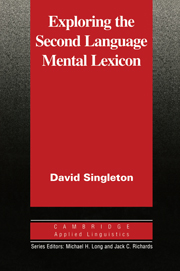Crossref Citations
This Book has been
cited by the following publications. This list is generated based on data provided by Crossref.
Singleton, David
1997.
Learning and processing L2 vocabulary.
Language Teaching,
Vol. 30,
Issue. 4,
p.
213.
Upjohn, Jonathan
1999.
Exit proficiency: The proof of the pudding.
ASp,
Vol. 23-26,
Issue. ,
p.
305.
Tesser, Carmen Chaves
and
Long, Donna Reseigh
2000.
The Teaching of Spanish Literature: A Necessary Partnership between the Language and Literature Sections of Traditional Departments.
Foreign Language Annals,
Vol. 33,
Issue. 6,
p.
605.
Zahar, Rick
Cobb, Tom
and
Spada, Nina
2001.
Acquiring Vocabulary through Reading: Effects of Frequency and Contextual Richness.
The Canadian Modern Language Review,
Vol. 57,
Issue. 4,
p.
541.
Read, John
and
Chapelle, Carol A.
2001.
A framework for second language vocabulary assessment.
Language Testing,
Vol. 18,
Issue. 1,
p.
1.
Viberg, Åke
2002.
Basic Verbs in Second Language Acquisition.
Revue française de linguistique appliquée,
Vol. Vol. VII,
Issue. 2,
p.
61.
Hilton, Heather
2002.
Modèles de l’acquisition lexicale en L2 : où en sommes-nous ?.
ASp,
Vol. 35-36,
Issue. ,
p.
201.
Hall, Christopher J.
2002.
The automatic cognate form assumption: Evidence for the parasitic model of vocabulary development.
IRAL - International Review of Applied Linguistics in Language Teaching,
Vol. 40,
Issue. 2,
Hulstijn, Jan H.
2003.
The Handbook of Second Language Acquisition.
p.
349.
Qian, David D.
2004.
Book Review: Assessing Vocabulary by John Read.
Language Assessment Quarterly,
Vol. 1,
Issue. 1,
p.
57.
Namei, Shidrokh
2004.
Bilingual lexical development: a Persian–Swedish word association study.
International Journal of Applied Linguistics,
Vol. 14,
Issue. 3,
p.
363.
Jiang, Nan
2004.
Semantic Transfer and Its Implications for Vocabulary Teaching in a Second Language.
The Modern Language Journal,
Vol. 88,
Issue. 3,
p.
416.
Kato, Toshihito
2005.
Learning strategies employed by Chinese-background learners in learning Japanese vocabulary.
Japanese Studies,
Vol. 25,
Issue. 3,
p.
271.
Jessner, Ulrike
2005.
Multilingual Metalanguage, or the Way Multilinguals Talk about Their Languages.
Language Awareness,
Vol. 14,
Issue. 1,
p.
56.
Navés, Teresa
Miralpeix, Immaculada
and
Luz Celaya, M.
2005.
Who Transfers More … and What? Crosslinguistic Influence in Relation to School Grade and Language Dominance in EFL.
International Journal of Multilingualism,
Vol. 2,
Issue. 2,
p.
113.
Lessing, A. C.
and
de Witt, M. W.
2005.
An investigation into the early literacy skills of Grade R Second-language (L2) learners in South Africa.
Africa Education Review,
Vol. 2,
Issue. 2,
p.
242.
Rast, Rebekah
2006.
Le premier contact avec une nouvelle langue étrangère : comment s’acquitter d’une tâche de compréhension ?.
Acquisition et interaction en langue étrangère,
p.
119.
Rimmer, Wayne
2006.
Measuring grammatical complexity: the Gordian knot.
Language Testing,
Vol. 23,
Issue. 4,
p.
497.
Singleton, David
and
Ó Laoire, Muiris
2006.
Psychotypologie et facteur L2 dans l’influence translexicale.
Acquisition et interaction en langue étrangère,
p.
101.
Zareva, Alla
2007.
Structure of the second language mental lexicon: how does it compare to native speakers' lexical organization?.
Second Language Research,
Vol. 23,
Issue. 2,
p.
123.



